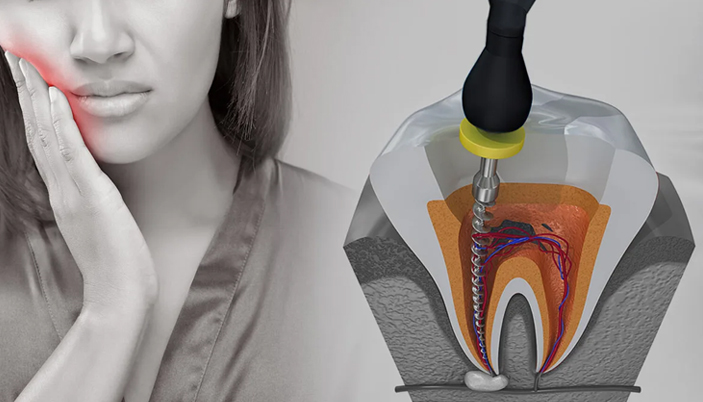The Latest Advances in Endodontic Treatment
Did you know that over 15 million root canal treatments are performed annually in the United States alone? It’s a common procedure, but you may not know that there have been significant advancements in endodontic treatment in recent years. Endodontics is the process of removing infected nerves in your tooth. This ensures that infected teeth will not cause an abscess, leading to bone loss and painful infections. This treatment usually lasts as long as your natural teeth. The field of endodontics is constantly evolving from advanced imaging techniques that provide more accurate diagnoses to innovative root canal instruments that improve efficiency and precision.
But that’s not all. There are also biocompatible materials, minimally invasive procedures, regenerative endodontics, and the integration of digital dentistry. These latest advances are revolutionizing root canals, leading to more successful outcomes and enhanced patient comfort.
So, if you’re curious to learn about the cutting-edge techniques and technologies shaping the future of endodontic treatment, keep reading to discover how these advancements are transforming the field.
Advanced Imaging Techniques
Advanced imaging techniques play a crucial role in the field of endodontic treatment. These advanced techniques have revolutionized the way dentists diagnose and treat various dental conditions.
One such technique is the use of cone-beam computed tomography (CBCT), which provides high-resolution 3D images of the teeth and surrounding structures. CBCT allows dentists to visualize the tooth’s anatomy accurately, detect hidden canals, and assess the extent of the infection. This information is invaluable in planning and executing successful endodontic procedures.
In addition to CBCT, digital radiography has also emerged as a vital imaging tool in endodontics. Digital radiographs offer many advantages over traditional film radiographs, such as reduced radiation exposure and instant image availability. These high-quality images aid in the accurate diagnosis of dental conditions, including root fractures, periapical pathology, and resorption.
Innovative Root Canal Instruments
To further enhance the precision and efficiency of endodontic treatment, the field has seen significant advancements in the development of innovative instruments specifically designed for root canal procedures. These instruments have revolutionized the way root canals are performed, allowing for improved outcomes and patient comfort.

Here are four innovative root canal instruments that are currently being used in the field:
1. Rotary Files: These flexible files are made of advanced nickel-titanium alloys, allowing for greater resistance to fracture and improved cutting efficiency. They can navigate curved canals with ease, removing infected tissue and shaping the canal walls accurately.
2. Apex Locators: These electronic devices use electrical resistance measurements to determine the exact location of the root apex. This ensures that the root canal is cleaned and filled to the precise length, minimizing the risk of overfilling or underfilling.
3. Ultrasonic Irrigation Systems: By using ultrasonic waves, these systems effectively remove debris and disinfect the root canal system. The vibrating tips create cavitation, which helps to disrupt biofilms and remove bacteria from hard-to-reach areas.
4. Obturation Systems: These systems use advanced techniques and materials to fill the root canal space after cleaning. They ensure a tight seal and prevent reinfection, promoting successful healing.
These innovative root canal instruments have revolutionized the field of endodontics, allowing for more precise and efficient treatment outcomes.
Biocompatible Materials
Biocompatible materials play a crucial role in ensuring successful endodontic treatment outcomes. These materials are specifically designed to be compatible with the human body, minimizing the risk of adverse reactions or complications. When it comes to endodontic treatment, biocompatible materials are used in various stages of the procedure to optimize results.
One commonly used biocompatible material is gutta-percha, a natural rubber that’s thermoplastic and biologically inert. It’s used to fill and seal the root canal space after the infected pulp has been removed. Gutta-percha is an excellent choice because it adapts well to the root canal anatomy, ensuring a tight seal and preventing reinfection.
Another important biocompatible material is the sealer. Sealers are used to fill the gaps between gutta-percha cones and the root canal walls, providing a complete seal. Epoxy resin-based sealers are commonly used due to their excellent biocompatibility and sealing properties. These sealers have a low incidence of allergic reactions and provide a strong bond to dentin.
In recent years, bioactive materials have gained popularity in endodontics. These materials have the ability to release bioactive ions, such as calcium and phosphate, promoting dentin remineralization and reducing the risk of secondary caries. They also possess antibacterial properties, preventing bacterial colonization within the root canal system.
Minimally Invasive Procedures
Minimally invasive procedures offer a less invasive approach to endodontic treatment, maximizing your comfort and ensuring optimal outcomes. By minimizing the amount of tissue and tooth structure that needs to be removed, these procedures provide several benefits:
1. Precise Imaging: Advanced imaging techniques, such as cone beam computed tomography (CBCT), allow your endodontist to accurately diagnose and plan your treatment. This ensures that only the necessary areas are treated, reducing unnecessary intervention.
2. Microscopic Precision: With the use of high-powered microscopes, your endodontist can visualize the root canal system in great detail. This enables them to locate and treat even the smallest canals, ensuring complete disinfection and sealing.
3. Smaller Incisions: Minimally invasive procedures typically involve smaller incisions or access points, resulting in less trauma and faster healing. This means less post-operative pain and discomfort for you.
4. Preservation of Tooth Structure: By adopting minimally invasive techniques, your endodontist can preserve more of your natural tooth structure. This not only maintains the aesthetics of your smile but also helps to maintain the strength and function of the treated tooth.
Regenerative Endodontics
With the preservation of tooth structure in mind, regenerative endodontics offers a groundbreaking approach to endodontic treatment that focuses on restoring the vitality and function of the tooth. This innovative technique aims to regenerate the damaged pulp tissue, allowing for the natural healing and growth of the tooth.
Regenerative endodontics involves a series of steps that promote the growth of new tissues within the root canal. First, the infected or necrotic pulp tissue is removed, and the root canal is thoroughly cleaned and disinfected. Next, a bioactive material, such as mineral trioxide aggregate (MTA) or calcium hydroxide, is placed within the root canal to stimulate the growth of new tissue.
To enhance the regenerative process, a blood clot or a scaffold made of biocompatible materials can be placed in the root canal. This provides a framework for the growth of new blood vessels, nerve fibers, and dental pulp cells. Over time, the regenerative process restores the vitality and function of the tooth, allowing it to continue developing and maturing.
Regenerative endodontics has shown promising results in both immature and mature teeth, particularly in cases where traditional endodontic treatment would result in tooth extraction. By preserving the natural tooth structure and promoting the regeneration of healthy tissues, regenerative endodontics offers a more conservative and sustainable approach to endodontic treatment.
Digital Dentistry in Endodontics
Digital dentistry has revolutionized the field of endodontics, providing more accurate diagnosis, treatment planning, and execution of procedures. With the help of advanced technology, dentists can now offer better and more efficient care to their patients.
Here are some ways in which digital dentistry is transforming endodontics:
1. CBCT Imaging: Cone Beam Computed Tomography (CBCT) allows for detailed 3D imaging of the teeth, roots, and surrounding structures. This enables dentists to accurately diagnose and assess the extent of endodontic problems, such as root fractures and periapical lesions.
2. Intraoral Scanners: Instead of messy and uncomfortable traditional impressions, digital scanners can capture precise digital impressions of the teeth, making the fabrication of custom-made endodontic appliances, such as dental crowns and bridges, more accurate and efficient.
3. Computer-Aided Design/Computer-Aided Manufacturing (CAD/CAM): CAD/CAM technology enables dentists to design and fabricate restorations, such as dental implants and endodontic posts, with high precision and efficiency. This eliminates the need for traditional manual fabrication methods.
4. Digital Endodontic Workflows: Digital platforms and software have streamlined the workflow of endodontic procedures. From treatment planning to the execution of root canal therapy, digital dentistry allows for more predictable and efficient outcomes.
Digital dentistry has truly transformed the field of endodontics, enhancing the quality of care and improving patient experiences.
Frequently Asked Questions
What Are the Common Symptoms That May Indicate the Need for Endodontic Treatment?
If you’re experiencing tooth pain or sensitivity to hot or cold temperatures, it could be a sign that you need endodontic treatment. Other common symptoms include swollen gums, a persistent bad taste in your mouth, or a pimple-like bump on your gums.
These symptoms may indicate that the innermost part of your tooth, known as the pulp, is infected or damaged.
Endodontic treatment can help alleviate these symptoms and save your tooth.
How Long Does the Healing Process Typically Take After a Root Canal Procedure?
After a root canal procedure, the healing process typically takes a few days to a few weeks. It depends on various factors such as the complexity of the case and your body’s healing ability.
It’s common to experience some discomfort or sensitivity during this time, but it should gradually improve.
It’s important to follow your dentist’s post-operative instructions, such as taking any prescribed medications and avoiding certain foods, to ensure a smooth and speedy recovery.
Are There Any Potential Risks or Complications Associated With Endodontic Treatment?
There can be potential risks or complications associated with endodontic treatment. These can include infection, nerve damage, or a failed root canal. It’s important to discuss any concerns or medical conditions you have with your dentist before the procedure.
Following post-treatment instructions and maintaining good oral hygiene can help minimize these risks. Be sure to contact your dentist if you experience severe pain, swelling, or any other unusual symptoms after the treatment.
Can Endodontic Treatment Be Performed on Primary (Baby) Teeth?
Yes, endodontic treatment can be performed on primary (baby) teeth. It’s important to save these teeth to maintain proper chewing and speech development.
The procedure involves removing the infected pulp and filling the root canals with a biocompatible material. This helps to preserve the tooth until it naturally falls out.
Your dentist will evaluate the condition of the tooth and determine if endodontic treatment is necessary.
Is Endodontic Treatment Covered by Dental Insurance?
Yes, endodontic treatment is often covered by dental insurance.
However, it’s important to check your specific plan to determine the extent of coverage.
Some insurance plans may only cover a portion of the treatment costs, while others may cover it in full.
It’s always a good idea to contact your insurance provider and inquire about the details of your coverage.
They can provide you with information on what procedures are covered and any potential limitations or requirements.
Conclusion
You’ve learned about the latest advances in endodontic treatment.
Advanced imaging techniques, innovative root canal instruments, biocompatible materials, minimally invasive procedures, regenerative endodontics, and digital dentistry are all contributing to improved patient outcomes.
With these advancements, dentists can provide more accurate diagnoses, perform less invasive procedures, and use materials that promote healing and durability try here .
Embracing these advancements will continue to revolutionize the field of endodontics and enhance the quality of dental care for patients.

Welcome to my website! I am Patrick Oxenham, a dedicated and passionate Pediatric Dentist with years of experience in providing comprehensive dental care for children. I am thrilled to share my knowledge and expertise in smile restoration methods, aesthetic dentistry updates, and gum health and grafting with you.

